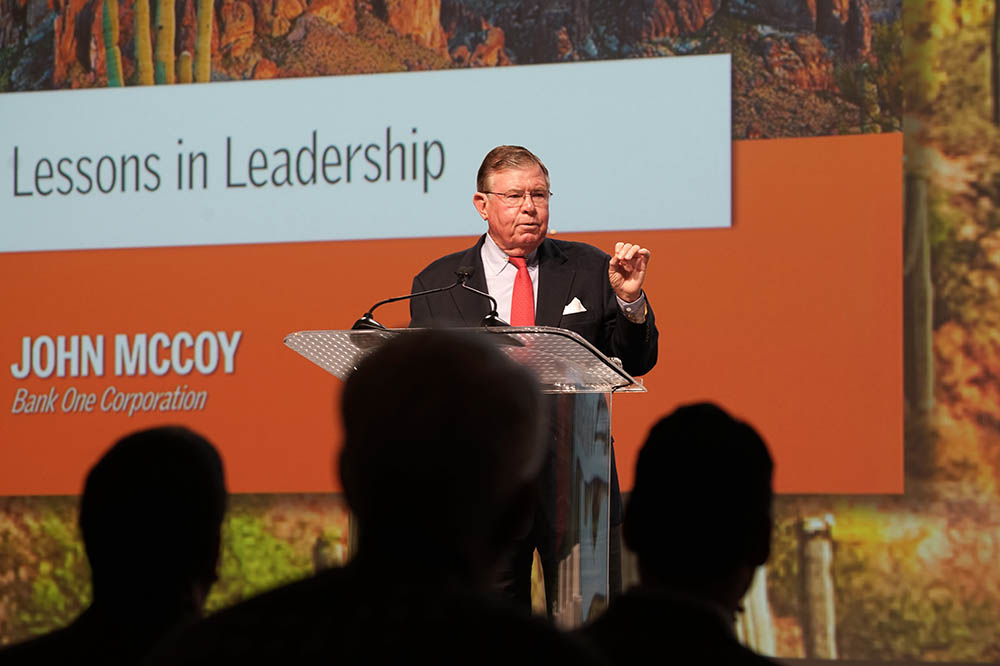
How History’s Playbook Can Help You Grow Today
 One might assume that many attendees at Bank Director’s Acquire or Be Acquired Conference in Arizona left town with an M&A game plan focused solely on their next acquisition, but a legendary banker suggested a different strategy.
One might assume that many attendees at Bank Director’s Acquire or Be Acquired Conference in Arizona left town with an M&A game plan focused solely on their next acquisition, but a legendary banker suggested a different strategy.
John B. McCoy, the former chairman and chief executive officer of Banc One Corp., recommended during a presentation on the final day of the conference that bankers consider a strategy his father used that ended up revolutionizing banking.
This year’s conference, which celebrated its 25th anniversary, was held at the JW Marriott Phoenix Desert Ridge resort in Phoenix.
McCoy’s advice is a page taken directly from the playbook of his father, John G. McCoy, who founded Bank One and turned it into a regional powerhouse before it was eventually acquired by JPMorgan Chase & Co. in 2004.
“One of the things he did, which I suggest for all of you, is he set aside that first year 4 percent of the profits, (which) went to (research and development) to do new things, not fix old problems,” McCoy said.
The advice is especially prescient today because the banking industry is being pressured to keep pace with an evolving digital economy and changing customer preferences for how they bank, especially in the retail sector.
Bank One spent that money building an exceptional retail franchise. It was the first bank to place ATMs in every branch, add drive-thru lanes at its branches, offer a Bank of America credit card and essentially invent the country’s first debit card.
“That set us off,” McCoy said. “One took us to the next.”
That investment strategy played an important role in its growth: Bank One’s assets grew from $140 million in 1958—when it was the smallest of three banks in Columbus, Ohio—to more than $8 billion 25 years later, eventually becoming the sixth-largest bank in the country.
Early in its history, Bank One pursued an ambitious M&A strategy where it bought dozens of small banks—first in Ohio and later in surrounding states—using a concept that it called the “Uncommon Partnership,” where it would leave the management team of the acquired bank in place while centralizing many of its back office functions to save money. In fact, McCoy said they would only acquire a bank if the CEO agreed to stay in place.
Bank One also limited the risks of its acquisition program by never buying a bank that was more than 20 percent of its own asset size.
An announcement on Monday that Detroit-based Chemical Financial Corp. was acquiring Minneapolis-based TCF Financial in a $3.6 billion deal, creating the country’s 27th largest bank with $45 billion in assets, also generated a lot of talk during the conference. Chemical and TCF billed the transaction as a merger of equals even though Chemical’s shareholders will own 54 percent of the merged company.
While some some conference presenters suggested that mergers of equals could occur with more frequency given the recent declines in bank valuations, which has made it more difficult for acquirers to pay a big takeover premium, others were more skeptical.
Tom Brown, founder and CEO of the hedge fund Second Curve Capital, which invests exclusively in banks and other financial companies, doubted that those deals will become regular. For one thing, there are significant social issues to resolve, like which CEO will end up running the company, how many directors from the two banks will constitute the new board and what will the new company’s name be. (In the TCF/Chemical deal, the new company’s headquarters will be in Chemical’s hometown of Detroit, but it will take the TCF name.)
“They’re just really tough to do,” Brown said during the conference’s closing session. “Someone who has been a CEO is not going to take a different role. And, while they all make great sense to me as an investor, the amount of work before the deal could even be agreed upon is just too challenging.”
Several speakers at the conference also said that smaller banks will need to gain scale to compete in a consolidating industry. Conventional wisdom says that scale helps improve efficiency, reduces costs and boosts profitability–but the urge to grow bigger purely for the scale must be tempered, Brown said.
“I talk to all sorts of CEO’s who are $250 billion assets and they still think they don’t have scale,” Brown said. “Let’s just stop using the get bigger to get scale idea because I haven’t seen that work yet.”

